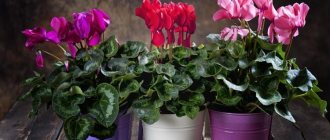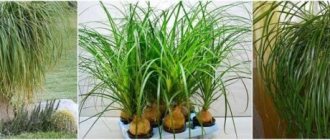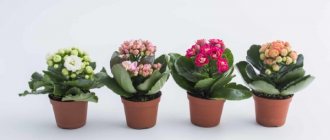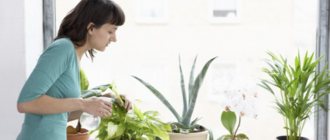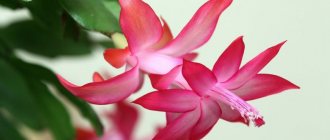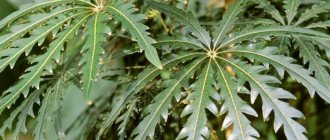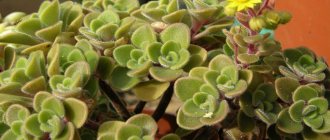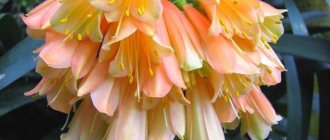An unusual and amazing plant is Kalanchoe, whose homeland and origin are hot African countries. In its natural habitat, the shrub can be found in Australia and America. The succulent is amazing not only for its beautiful flowering, but also for its beneficial properties. The flower is used in folk medicine because it has anti-inflammatory, disinfectant and analgesic properties.
The medicinal plant is distinguished by fleshy leaves that are smooth or rough to the touch, depending on the type. The color of the inflorescences also depends on the variety. The type of Kalanchoe root system is fibrous.
Interesting fact! There are about two hundred varieties of Kalanchoe. Some varieties were bred artificially and do not grow in nature.
What does Kalanchoe look like?
It is a genus of plants with enormous diversity. Kalanchoes differ greatly from each other in height, leaf size, stem shape and even color. It is best to study Kalanchoe in a photo. It is noticeable from them that the genus includes trees 4 meters tall and bushes 20 cm tall.
The plant is rich in shades. The leaves and stems range from bright green to blue-blue. There are both round and sharp leaf shapes.
Reproduction
Succulent propagation is possible in several ways: seeds, cuttings and leaves.
Seeds
To grow by seeds, you can purchase ready-made seeds in the store or collect them from the plant. Seeds must be sown in the first days of March. For planting, you need to prepare a container filled with turf soil. After the sprouts reach a size of 3–4 cm, they can be planted in separate pots.
Cuttings
A simple and quick method of propagation is cuttings. To make cuttings, you need to take a healthy branch of a bush and place it in a jar of water. After the first roots appear, the cuttings are transplanted into pots.
Sheet
Only healthy leaves are suitable for leaf propagation. For rooting, you need to place the leaves in containers filled with water. When the roots appear, you need to plant a small shoot in a pot with turf-moistened soil.
Varieties
If you need Kalanchoe with medicinal properties, then there are only three varieties:
- Kalanchoe Degremona, it has elongated leaves with a sharp end and teeth along the edge. It does not bloom, but reproduces well, producing babies on its teeth.
- Kalanchoe pinnate is a flowering plant with small pink-yellowish flowers. This house doctor is grown to produce medicines for the treatment of surgical, gynecological and dental diseases.
- Kalanchoe Blossfeld - It blooms with small white, red or orange flowers. The flowering period occurs in winter and spring. It has very distinctive leaves, they are fleshy and shiny.
Other species are also popular for growing Kalanchoe at home, requiring a minimum of plant care skills. But these three varieties have medicinal properties.
Cirrus
Beginning gardeners often ask the question of what Kalanchoe pinnate looks like. It is distinguished by more complex leaves, which can be bright green, light green, or purple. In nature it grows up to two meters in height; in indoor conditions the dimensions are certainly more modest. Drooping large flowers have a purple or rich red hue.
How to properly collect and store
The plant grows all year round. If you need a leaf, you can come up at any time and pick it. If Kalanchoe is being prepared for planned treatment, then the preparation is approached scientifically:
- stop watering, wait a week;
- cut off the lower leaves;
- wash the raw materials thoroughly in running water and wipe dry;
- keep in the refrigerator in the bottom fruit drawer for 5-7 days.
This step-by-step collection process allows the beneficial properties to develop and accumulate. Properly prepared leaves can be used to make infusions, ointments and other dosage forms.
Medicinal properties
Such a rich chemical set determines the long list of medicinal properties of Kalanchoe:
- Promotes rapid regeneration.
- Destroys pathogenic microorganisms and demonstrates good bactericidal and bacteriostatic properties.
- Inhibits the development of the inflammatory process.
- Stops minor bleeding, has a beneficial effect on blood flow, so it can help even with varicose veins.
- Solves problems of skin diseases.
The plant is used to treat female diseases; it promotes rapid healing of erosions, tears and cracks. Compresses with leaves help improve well-being in case of prostate adenoma and prostatitis. Children over 1 year of age and pregnant women can instill diluted juice into the nose for a runny nose.
Kalanchoe can be included in comprehensive weight loss programs. It helps activate the digestive system and tones the body.
Features of cultivation
Kalanchoe is one of the plants with moderate requirements for growing conditions. Let's look at the key factors.
Lighting
With a few exceptions, most representatives need a few hours a day in the sun and the rest in bright shade.
The lighting mode must be maintained for the plant to bloom (more details).
Temperature
Comfortable temperature is 17-19ºС.
In summer, an increase to 28ºС is allowed. A moderate decrease in this indicator will not be critical. However, too hot an environment negatively affects the growth and health of the flower, as does lowering the thermometer below +10ºС. Kalanchoes do not tolerate frost at all and can be damaged even when the temperature drops to +4ºС. In winter, the plant is kept at a temperature of 12-14ºС.
- Kalanchoe luciae @entireleaves, Flickr
- Kalanchoe delagoensis @Adam Kopras, Flickr
Priming
To grow Kalanchoe, you can use a ready-made nutrient substrate for succulents with added drainage. Or make your own soil mixture based on the following proportions:
- leaf soil - 2 parts;
- turf soil - 4 parts;
- sand - 1 part;
- peat - 1 part.
Pot
To plant Kalanchoe, you can take either a plastic or ceramic pot.
But a clay container is most suitable. It is important to choose the size of the pot so that after placing the succulent there is not a lot of free space left in it. The plant has a small root system, so it is advisable to use pots with a diameter of 12-18 cm.
In what form is it used for treatment?
After harvesting, Kalanchoe can be stored in different forms:
- infusion;
- ointment;
- tincture;
- decoction;
- juice.
For long-term use, it is better to make tinctures with alcohol; they retain the properties of plants for up to 1 year. You can add the plant juice to odorless olive or sunflower oil.
Kalanchoe in folk medicine
Its application is very wide! It treats scratches and helps maintain normal calcium levels in the body, which is especially important for diabetes. Tannins will protect the gastric mucosa during gastritis.
Kalanchoe also normalizes stool, improves appetite and relieves symptoms of colitis, gastroduodenitis and enterocolitis. It is added to liver preparations, and compresses are made with it to reduce hemorrhoids.
This is a great help for colds! Kalanchoe treats a runny nose, relieves coughing and symptoms of sinusitis.
Cultivars, forms
They hybridize easily with some other species, especially Kalanchoe degremona and Kalanchoe rosea. The most common of its hybrids is Kalanchoe x houghtonii (Kalanchoe daigremontiana × Kalanchoe delagoense) - very similar to Kalanchoe daigremontiana, but with narrower leaves.
Kalanchoe Pink Butterflies (Pink Butterfly)
Houghton's Kalanchoe
Bibliography:
- International Crassulaceae Network, https://www.crassulaceae.ch/
Contraindications
The plant has contraindications for oral administration:
- severe diabetes mellitus;
- hepatitis;
- cirrhosis of the liver;
- oncology;
- joint diseases;
- bronchial asthma;
- reduced blood pressure;
- pregnancy.
External use is almost safe, you should be aware of allergic reactions.
Are fresh leaves good for eating?
The leaves taste bitter, so it is often mixed in salads with cucumbers. It also goes well with carrots, green salad, avocado, and fresh peas.
Kalanchoe can be added to a regular vinaigrette, but it works like a seasoning - it depends on the taste. If there are a lot of leaves, they will “clog” the main taste.
Possible problems
The most common problems when growing Kalanchoe:
| Problem | Possible reasons |
| The shoots stretch out and the leaves begin to turn yellow | Lack of lighting |
| Wilting, drying of leaves | Air temperature too high |
| Stopping growth | Lack of nutrients Most often observed after active flowering. |
| Soft, fragile stems | Overwatering or planting in soil that retains water well. |
| Lack of flowering | Most often - non-compliance with wintering conditions. |
How to properly care for Kalanchoe
He is not whimsical, but you need to remember a few basic rules:
- The recommended temperature in winter is +15, and in summer – +20…+25 degrees.
- In the warm season, Kalanchoe loves sunbathing in the fresh air. It can be taken out onto the balcony.
- Do not place in drafts.
- Kalanchoe loves the eastern side, where there is sun until lunchtime.
- In summer, water 1-2 times a week, in winter 2-4 times a month.
- It is recommended to replant in the spring.
- There should be drainage at the bottom of the pot.
- Propagated by children, seeds and cuttings.
Degremona
Degremona is the most popular variety, which is known to almost everyone. The plant is loved by gardeners due to its unique medicinal properties. This type of Kalanchoe has oblong, dense, leathery leaves. A distinctive feature of the variety are the babies (brood buds), which are located along the edges of the leaf blades. This species is also called viviparous, because the babies fall off and, falling on the soil, take root. Interested to know what medicinal Kalanchoe looks like? The photo is presented above.
Photo of Kalanchoe
Total
Category: Flower beds and flower beds
